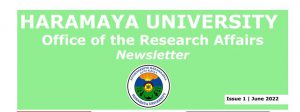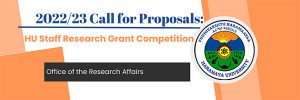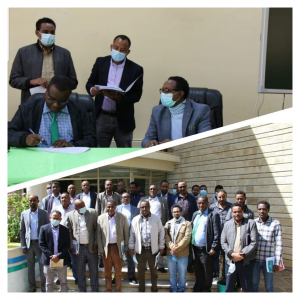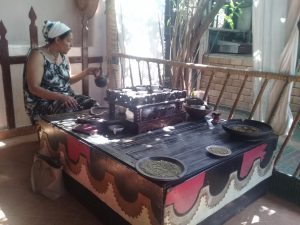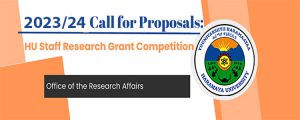Community Engagement Necessary in Research Works
The 34th Annual Research, Extension and Community Engagement Review and Exhibition was held in Haramaya University’s Afran Kallo Hall and Resource Center for three consecutive days. The review was started with a discussion session with Eastern and Western Hararghe stakeholders. In attendance were model farmers, Development Agents (DAs), community elders, woreda and district administration representative and the HU’s managerial staff together with the University’s community. The discussion that was held in the local language, Afan Oromo gave the opportunity for the locals to express their concerns and appreciations with no difficulty.
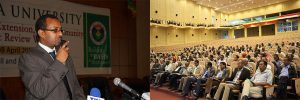 Four presentations were made focusing on research extension activities of the University, activities undertaken by BENEFIT-ISSD in the area, community engagement and watershed management activities before the floor was opened for discussion. Many of the farmers were happy with the progress the University has made following the discussion they had last year on the 33rd Annual Review and expressed their gratitude.
Four presentations were made focusing on research extension activities of the University, activities undertaken by BENEFIT-ISSD in the area, community engagement and watershed management activities before the floor was opened for discussion. Many of the farmers were happy with the progress the University has made following the discussion they had last year on the 33rd Annual Review and expressed their gratitude.
One model farmer expressed his appreciation for the fact that the University has acknowledged the need to work with the community, and raised whether or not research work on mango disease, which has become a severe threat to mango production in Babile area given enough attention. In response to this question, Prof. Nigussie Dechassa, Vice-president for Academic Affairs, said some activities are going on mango involving experts and professionals. In addition to these activities, a postgraduate student is also working on his PhD in mango, and hopefully, disease prevention and identification of insects that damage the fruit will also be taken as a research agenda by the University’s researchers.
The University’s focus on what the farmers called ‘less priority crops’ was another issue raised and it was commented that the University has not reduce its researches only to common beans and the ‘less priority crops’, rather its researchers and extension workers are heavily invested on crops such as maize and sorghum which are taken as the priority crops in the area. Prof. Nigussie said, “Common bean is still taken as a priority crop in many areas and it is a crop for export serving as a cash crop.’ Research on the bean as well as other crops will continue in the future too.” The two new maize varieties released in 2017 are clear indications of the University’s commitment to improve the livelihoods of the community.
The preparation and distribution of manuals along with technologies, the speed of technology dissemination, and the application and sever effect of chemicals on Khat were also issues raised during the discussion. Dr. Abera Deressa, the University’s Board Member, emphasized that research on Khat is not a priority for the Ethiopian Government and neither is it for Haramaya University; Prof. Nigussie iterated the University would not allocate public fund for undertaking research on the crop due to policy reasons. As for the preparation and distribution of manuals for newly adopted and released technologies, the manuals are prepared in the local languages, and are ready to be disseminated, but the University would also take it under advisement to provide manuals simultaneously with the release of technologies.
 Opening up new primary schools in various rural areas and the support given to schools was also raised up by one attendee, and Prof. Kebede W/Tsadik, Vice-president for Community Engagement and Enterprise Development said, “More than 100 high schools have been supported. We cannot address all requests. We only do limited support. Our community engagement support is possible only when the community starts doing something and requires additional support from us. It cannot allocate the budget it receives from the government treasury to construct schools.” In line with this Dr. Abera said, “We […] need to know [the] responsibilities of the University. The major responsibility is human power development (teaching) while research and community engagement are the additional responsibilities …. All the different ministries and offices have their own responsibilities to fulfill. Educational offices should also fulfill their responsibilities and the University may support them.”
Opening up new primary schools in various rural areas and the support given to schools was also raised up by one attendee, and Prof. Kebede W/Tsadik, Vice-president for Community Engagement and Enterprise Development said, “More than 100 high schools have been supported. We cannot address all requests. We only do limited support. Our community engagement support is possible only when the community starts doing something and requires additional support from us. It cannot allocate the budget it receives from the government treasury to construct schools.” In line with this Dr. Abera said, “We […] need to know [the] responsibilities of the University. The major responsibility is human power development (teaching) while research and community engagement are the additional responsibilities …. All the different ministries and offices have their own responsibilities to fulfill. Educational offices should also fulfill their responsibilities and the University may support them.”
“The second rank the Grawa Hospital obtained among the hospitals in Oromia Region is because of the tremendous support it has obtained from the University,” said a representative from Gurawa. “But the BENEFIT-ISSD Project should also work in Gurawa Woreda, in addition to their ‘road-side’ efforts.” Mr. Dendena Gelmessa responded, the BENEFIT-ISSD Project is trying to include more woredas under its umbrella and Gurawa may be one of them.
Dr. Jemal Yousuf, Vice-president for Research Affairs, gave response to questions regarding groundwater potential and assessment in neighboring areas and he said identification and location of potential groundwater resource has already been secured, and implementation in collaboration with stakeholders will take place in the near future.
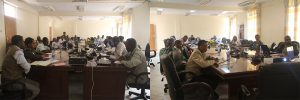 The Annual Review was held from 6-8 April, 2017 and more than 430 individuals attended the event. Under the research thematic areas, 57 scientific works were presented for review on the second and third day of the review. An exhibition displaying the various research, extension and community engagement activities of the University and its various organs was held and the response and feedback from the attendees was encouraging.
The Annual Review was held from 6-8 April, 2017 and more than 430 individuals attended the event. Under the research thematic areas, 57 scientific works were presented for review on the second and third day of the review. An exhibition displaying the various research, extension and community engagement activities of the University and its various organs was held and the response and feedback from the attendees was encouraging.

